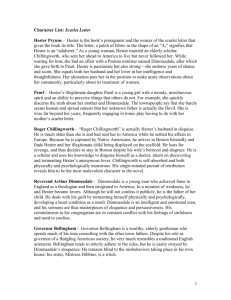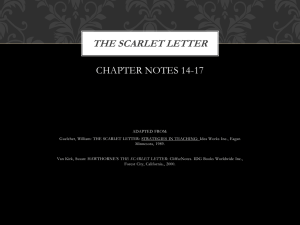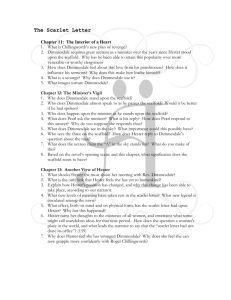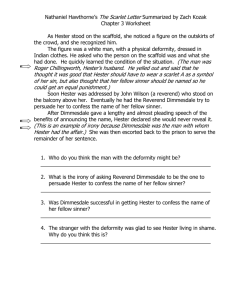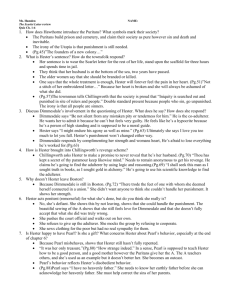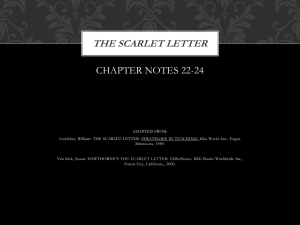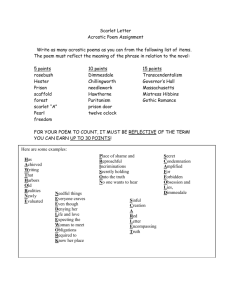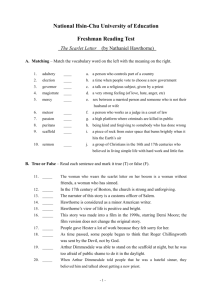Scarlett Letter by Nathaniel Hawthorne
advertisement
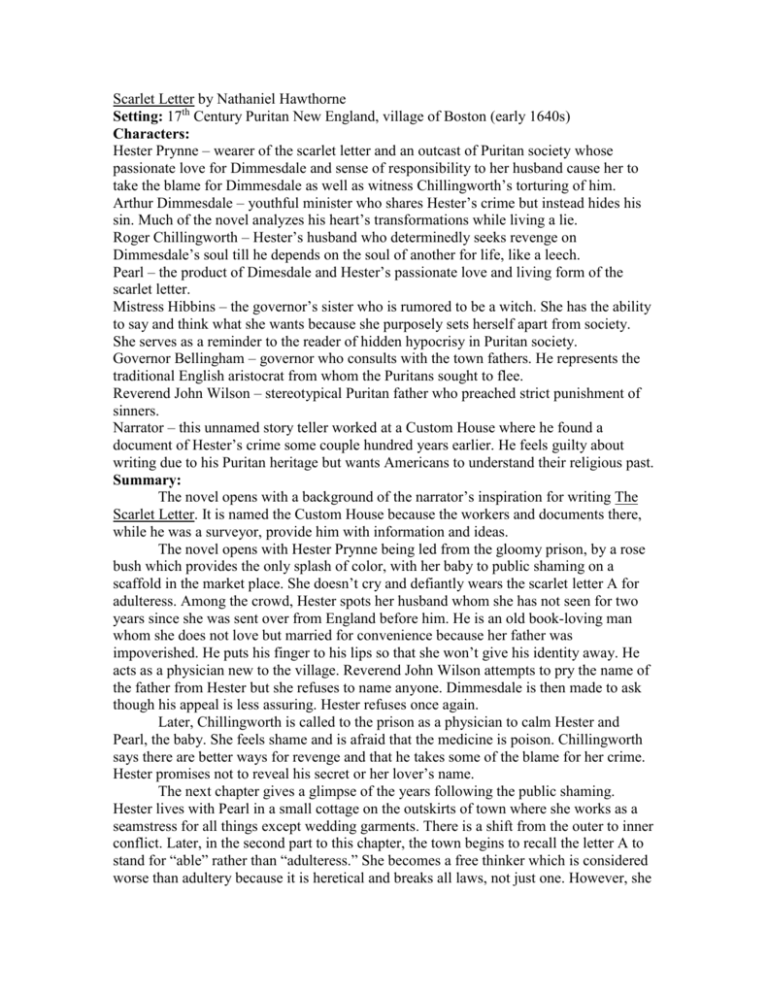
Scarlet Letter by Nathaniel Hawthorne Setting: 17th Century Puritan New England, village of Boston (early 1640s) Characters: Hester Prynne – wearer of the scarlet letter and an outcast of Puritan society whose passionate love for Dimmesdale and sense of responsibility to her husband cause her to take the blame for Dimmesdale as well as witness Chillingworth’s torturing of him. Arthur Dimmesdale – youthful minister who shares Hester’s crime but instead hides his sin. Much of the novel analyzes his heart’s transformations while living a lie. Roger Chillingworth – Hester’s husband who determinedly seeks revenge on Dimmesdale’s soul till he depends on the soul of another for life, like a leech. Pearl – the product of Dimesdale and Hester’s passionate love and living form of the scarlet letter. Mistress Hibbins – the governor’s sister who is rumored to be a witch. She has the ability to say and think what she wants because she purposely sets herself apart from society. She serves as a reminder to the reader of hidden hypocrisy in Puritan society. Governor Bellingham – governor who consults with the town fathers. He represents the traditional English aristocrat from whom the Puritans sought to flee. Reverend John Wilson – stereotypical Puritan father who preached strict punishment of sinners. Narrator – this unnamed story teller worked at a Custom House where he found a document of Hester’s crime some couple hundred years earlier. He feels guilty about writing due to his Puritan heritage but wants Americans to understand their religious past. Summary: The novel opens with a background of the narrator’s inspiration for writing The Scarlet Letter. It is named the Custom House because the workers and documents there, while he was a surveyor, provide him with information and ideas. The novel opens with Hester Prynne being led from the gloomy prison, by a rose bush which provides the only splash of color, with her baby to public shaming on a scaffold in the market place. She doesn’t cry and defiantly wears the scarlet letter A for adulteress. Among the crowd, Hester spots her husband whom she has not seen for two years since she was sent over from England before him. He is an old book-loving man whom she does not love but married for convenience because her father was impoverished. He puts his finger to his lips so that she won’t give his identity away. He acts as a physician new to the village. Reverend John Wilson attempts to pry the name of the father from Hester but she refuses to name anyone. Dimmesdale is then made to ask though his appeal is less assuring. Hester refuses once again. Later, Chillingworth is called to the prison as a physician to calm Hester and Pearl, the baby. She feels shame and is afraid that the medicine is poison. Chillingworth says there are better ways for revenge and that he takes some of the blame for her crime. Hester promises not to reveal his secret or her lover’s name. The next chapter gives a glimpse of the years following the public shaming. Hester lives with Pearl in a small cottage on the outskirts of town where she works as a seamstress for all things except wedding garments. There is a shift from the outer to inner conflict. Later, in the second part to this chapter, the town begins to recall the letter A to stand for “able” rather than “adulteress.” She becomes a free thinker which is considered worse than adultery because it is heretical and breaks all laws, not just one. However, she becomes the closest thing to a nun that Puritan religion allows. Pearl is paralleled to the scarlet letter as her nature is unruly and passionate. She hates the Puritan children who cast her off. Pearl is also fascinated by the scarlet letter and for this Hester often calls her an imp or demon. Hester visits Governor Bellingham because of rumors that she has heard concerning Pearl being taken from her. The magistrates rule in favor of removing her from her mother until Hester beseeches Dimmesdale for help. He is able to persuade the magistrates to let Hester keep Pearl. The chapters The Leech and The Leech and his Patient describe the relationship between Chillingworth and Dimmesdale. Chillingworth gets close with Dimmesdale as a physician and his revenge remains his sole reason to live. Chillingworth uncovers a letter A on the sleeping minister’s flesh, over his heart, similar to Hester’s. Chillingworth jumps for joy like the devil over a damned soul. This is the turning point in his character representation. The chapter, Interior of a Heart, focuses on Dimmesdale and his self-loathing. He realizes his hypocrisy as a Puritan minister living a lie in front of God. The village, however, loves his sermons. His sin has put him and the parishioners on a level playing field. He plans a vigil in which he stands on the scaffold in the market place at night. Reverend John Wilson walks by as does Hester and Pearl whom he invites to join him, as they were returning from Governor Winthrop’s deathbed. Pearl asks if he will stand with them during the day but he says “someday”. A meteor shaped like an A appears in the sky though the town interprets it to stand for “angel” for Winthrop’s passing. Hester confronts Chillingworth about letting Dimmesdale know his identity while Pearl plays on the beach, making an A on her chest out of seaweed. Hester leaves Chillingworth after she takes some of the blame for his evil transformation and he says that they are living their predestined fates. Hester and Pearl go to meet Dimmesdale in the woods after his return from the Native American establishments in the forest. Pearl observes that she can move into the sunshine but Hester cannot because of the “A”. Dimmesdale is angry at first about the news concerning Chillingworth. Hester uses her strength to tell him that he has to get away from Chillingworth and they plan to leave for Europe so they can live as a family. The pair becomes energized by this decision and Hester takes off the letter and lets her hair down. Sunlight floods the forest and Pearl is called over. Hester has to put the letter on for Pearl to come over. Pearl rejects Dimmesdale’s kiss because he will not walk back to the village with them. Three days later is Election Day in the village and a celebration. Dimmesdale, Hester and Pearl are to leave on a ship that departs the next day but Hester hears from a sailor that Chillingworth has joined them as well. Dimmesdale delivers an excellent sermon and then confesses his sin to the crowds on the scaffold with Hester and Pearl. Pearl finally kisses him. Dimmesdale collapses and dies. Chillingworth later dies because he was dependent on Dimmesdale’s soul though he leaves Pearl his heir. She marries and lives in Europe. Hester returns to New England and lives with the scarlet letter till her death when she is buried beside Dimmesdale. Their tombstone is the letter A. Symbolism: 1. Rose bush outside prison – nature is outside the confines of the Puritan world which allows beauty to flourish and crime finds tolerance and sympathy. 2. Scarlet letter – represents “adulteress” and is a symbol of shame. Hester transforms into the outcast that the red letter has made her and society reacts with hostility towards it. It creates Hester into an individual. Its significance changes from “able” to “angel” as well throughout the novel. 3. Pearl – is the living scarlet letter. Pearl is meant to keep Hester’s shame fresh and omnipresent even when Hester is away from the villagers. Pearl relates herself to the wild rosebush because she does not follow society’s rules beginning with her birth. 4. Armor in Governor Bellingham’s house – this armor serves to emphasize Hester’s scarlet letter and shame while located in the center of the Puritan establishment. When she looks into it her reflection is distorted behind the clear and enlarged image of the “A”. 5. The vigil scene with Dimmesdale, Hester and Pearl gazing at the meteor from the scaffold - symbolizes judgment day when the three will be judged together under the details of the crime of adultery and its result. Irony: Puritans take pride in publicly displaying wrongs and evils but the novel’s plot is driven by the two undercover lives of Chillingworth and Dimmesdale. Foreshadowing: At the end of Chapter 4, The Interview, when Chillingworth visits Hester and Pearl in jail, Hester is afraid of her soul’s ruination. She had just made a secret pact with Chillingworth to withhold his identity. However, Chillingworth says that it will not be her soul that is ruined. He ultimately means that it will be Dimmesdale’s but it actually turns out to be his own. Important: The Scarlet Letter is a study of sin’s effects on the human heart and mind. Themes: 1. Society and law are repressive to people’s individuality and freedom. 2. Individuals cannot function without remaining a part of society. 3. Cultivating the heart is safer and less fatal than cultivating the mind (Chillingworth is the embodiment of this theme gone bad). 4. Society attempts to curb the wilderness and passion in every human being. 5. Public and private self are two contrasting entities (viewed in the separation of forest and village activities and in the characters of Dimmesdale and Chillingworth).


